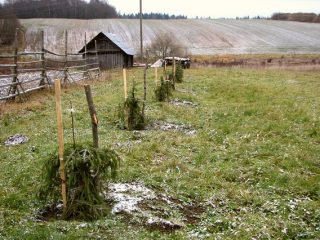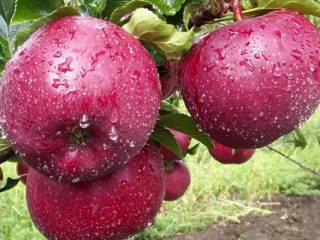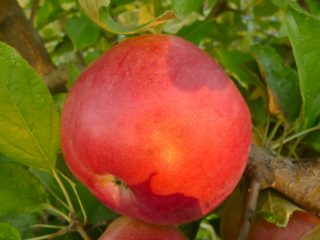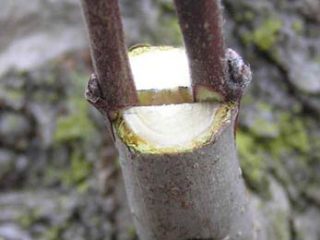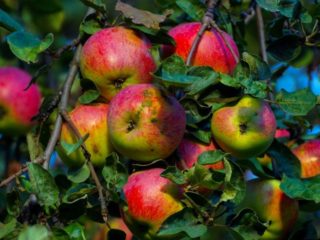Content
The apple tree Brother Chudny is an ideal solution for those who live in the northern latitudes of Russia. It is a natural dwarf with juicy yellow-green fruits, which gives a rich harvest and does not require special care. It will delight not only adults, but also young children who do not want to eat red fruits.
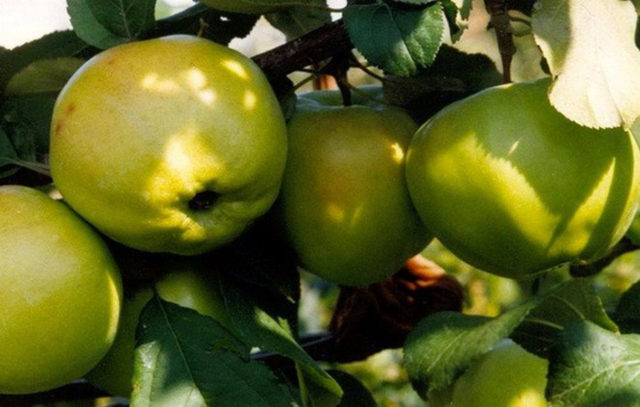
Apple variety Bratchud has the best yields in its category.
Breeding history
The originators of the Bratchud apple variety were breeders of the South Ural Research Institute of Fruit and Potato Growing (Chelyabinsk) Mazunin N.A., Mazunina N.F., Putyatin V.I. The purpose of their work was to obtain the most frost-resistant apple variety for growing in harsh Siberian climate. For this, breeders crossed the Ural winter apple trees and Vydubetskaya weeping apple trees. The Bratchud apple variety was registered in the State Register in 2002.
Description of the apple-tree variety Brother Chudny with a photo
The dwarf apple tree Bratchud is a winter variety that was developed for northern latitudes, but has become popular throughout Russia. Favorable conditions for its cultivation are as follows:
- lack of drafts on the site;
- soil saturated with minerals and nutrients;
- low occurrence of groundwater (to avoid stagnation and root rot);
- good access to sunlight, not shaded area.
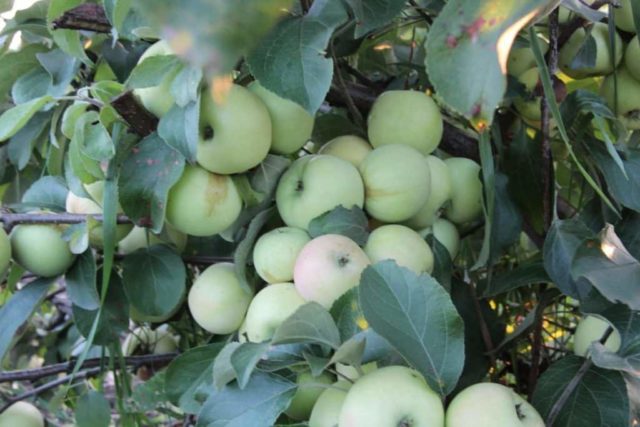
Bratchud apples contain many useful substances: pectins, ascorbic acid, titratable acids, soluble solids, sugar
Fruit and tree appearance
The height of the tree is from 2 to 2.5 m (a plant grown on rootstocks will not grow higher than 2 m). The crown girth reaches 3.5 m in diameter, has a high growth rate. Young branches are medium thick, bark is dark brown, branches and young shoots are younger, the lighter. Shoots grow horizontally, falling slightly downward. The foliage is rich green, large-crowned. Slight pubescence is traced on the upper part. From the branch, the foliage falls down to the ground.
The apples are round, slightly elongated towards the end, yellow-green in color with a barely noticeable blurred pink spot. On the sides of the fruit are thin convex sutures. The size is average, the approximate weight of one apple is 180 g, although it can vary from 110 g to 200 g. The peel is glossy, thin. There is no white coating. The pulp is juicy, granular structure. In a mature apple, it is white, in an unripe fruit, the flesh is greenish in color.
Life span
The lifespan of a tree of the Bratchud variety is significantly less than other varieties. The tree ceases to bear fruit after 18-20 years, which forces gardeners to replace it with young ones.
Taste
Bratchud apples have a sweet taste with a pleasant sourness. On a five-point scale, the fruits of the Bratchud apple tree are rated at 4.7 points.
Growing regions
The Bratchud apple tree is zoned for cultivation in the regions of the Urals and Siberia. In addition, it has taken root well in central Russia, in Altai and in the European north-west of the country.
Each region has some nuances in cultivation and care. For example, in the Moscow region, apple trees need increased watering. In the Urals, planting is carried out in a place where no fruit trees have grown before, and subsequent care must necessarily include abundant feeding. Bratchud apple trees planted in the middle lane can be damaged by strong winds. To prevent this, you should tie the apple tree to a support or place it near buildings on the leeward side. Siberian trees need good root protection from frost.
Yield
The productivity of the Bratchud apple-tree is annual and high. The fruits ripen at the same time. Up to 150 kg of fruit can be harvested from one adult tree.
Frost resistant
Created for cultivation in the harsh Siberian climate, the Bratchud apple variety can withstand the most severe frosts. The tree can tolerate wintering well at a temperature of -40 ° C. In climates with lower temperatures, the rhizome, which is susceptible to frost blows, should be protected.
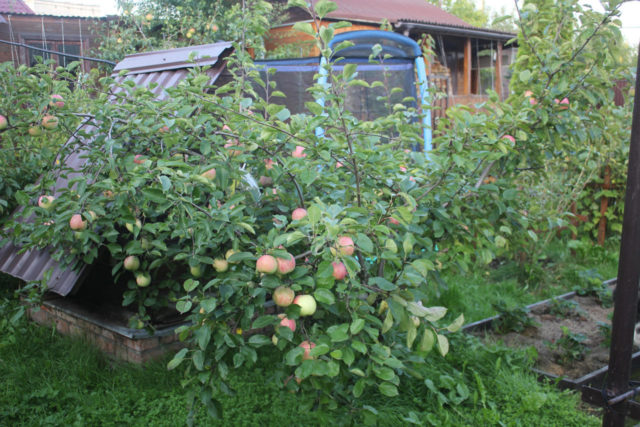
Apple tree Bratchud loves sunny places in order to maximize the heat and light necessary for the ripening of fruits
Disease and pest resistance
In contrast to its good resistance to low temperatures, the Bratchud apple tree has practically no immunity to fungal diseases. Therefore, the tree is often affected by scab and powdery mildew.
At the same time, oily light green spots appear on the back of the leaves. Subsequently, the fungus spreads to the fruit. For prevention, the apple tree is sprayed with a 3% solution of Bordeaux liquid twice a year: in early spring and during the budding period. Treatment after the flowering of the tree is carried out with fungicides, and after harvesting - with a 5% urea solution.
Flowering period and ripening period
Flowering begins in late April (or early May). In cold spring, it can start even at the end of May.
The first fruiting begins 3-4 years after planting. A feature of the Bratchud variety is that the fruits are formed on all branches: both on last year's shoots and on young ones. This is one of the reasons for the high yield of the tree. Ripening occurs in mid to late September. Since the apples do not crumble, you can pull until they are fully ripe with harvest. That is why the collection of fruits takes place in October.
Apple Pollinators Bratchud
The Bratchud apple tree requires cross-pollinators for the ovaries to appear. The most successful among them are the varieties Chudnoe, Snowdrop, Prizemlennoye, Sokolovskoye.
Transportation and keeping quality
Bratchud apples are characterized by good transportability. Despite the thin peel, the fruits can easily tolerate long and long transportation.
The keeping quality of Bratchud apples is also excellent. In the description of the variety, the originators define this period of 140 days.
Advantages and disadvantages
Apple trees of the Bratchud variety are distinguished by high yields. The fruits are distributed evenly throughout the tree, do not clump.
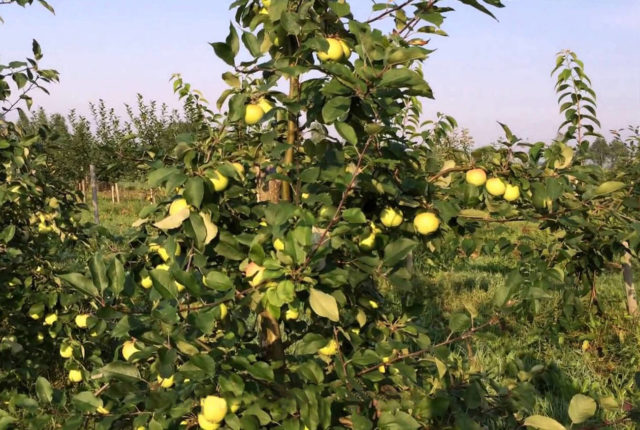
2-3 apples grow at one level of the tree
Pros:
- high resistance to prolonged frost;
- rich sweet and sour taste;
- storage duration;
- after ripening, the apples do not crumble;
- small height and even distribution of fruits on the branches makes the harvesting process convenient and fast;
- for the same reason, pruning dry and damaged branches is not difficult;
- a small amount of pink pigment allows you to give apples to young children, as well as those prone to allergies;
- saving space on the site;
- annual and abundant fruiting.
Minuses:
- lack of immunity to fungal diseases;
- slow increase in fruiting;
- poor tolerance of prolonged high temperatures and drought;
- relatively short lifespan of the tree.
Landing
The naturally low-growing Brother Chudniy apple tree is planted in spring or early autumn. A hole is dug with a diameter of 50 cm and the same depth.The extracted soil must be mixed with humus and peat in equal proportions.
The landing algorithm is as follows.
- Drive a high stake into an empty hole.
- Pour in about a third of the fertilized soil.
- Place the seedling in the hole, spread the roots.
- Sprinkle with the remaining soil, compact well and pour with 2-3 buckets of water.
Growing and care
Like planting, caring for the Brother Chudny apple tree is quite simple. It includes the following actions:
- Watering. For 1 season, the tree requires watering about 5 times. At a time, 5 buckets of water are introduced into the soil, which should be poured into the near-stem circle. After watering, the soil must be loosened to saturate it with oxygen and get rid of weeds.
- The soil around the trunk is mulched with hay, fallen leaves, sawdust.
- Top dressing should be done 4 times a season. In April, urea is used, during the flowering period - with complex mineral fertilizers. After the flowers have fallen off, the tree should be fertilized with nitrophos. After harvesting, phosphorus-potassium fertilizers are applied to the soil.
- Annual crown pruning. To do this, in early spring, frozen or dry branches are removed, and after harvesting, the upper buds on the shoots are subject to pruning.
- Preparation for wintering includes double abundant watering and additional mulching. In addition, to protect against rodents, the peri-stem ring should be protected with slate, and the trunk itself should be wrapped with roofing material.
Collection and storage
With timely collection, Bratchud apples tolerate long-term storage well. In a cool ventilated room (for example, a basement), at temperatures from + 3 to + 7 ° C, fruits can retain their qualities for 5 months. In the vegetable section of the refrigerator, the term may be extended by another 1 month.

A distinctive feature of the Bratchud apple variety is a strong stalk, which reliably keeps the fruits from shedding, so the collection takes place directly from the branches
Conclusion
Despite the fact that the Brother Chudny apple tree was bred for cultivation in northern latitudes, it pleases gardeners almost throughout Russia. Unpretentiousness and good indicators of productivity and frost resistance, together with the rich taste of the fruit, makes the variety one of the most promising and popular.
